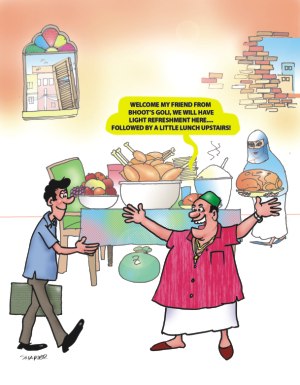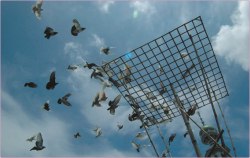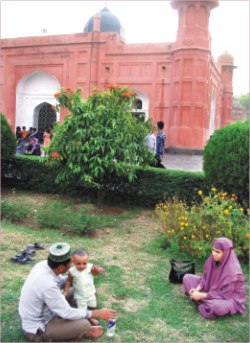 Colourful
Flavourful
Colourful
Flavourful
Dhakaiyas
Groups
of people vary across geographic distances. They form different and
at times weirdly unique cultures of their own. No one knows whether
it is the food they eat, the water they drink or the Daily Star supplements
they prefer to read that cause them to behave differently.
Within the confines
of Dhaka a particular people have for generations grown up and passed
away breathing the increasingly polluted air of the capital city.
They are known as Dhakaiyas or "kutti" and they have been
leaving their footprints since the 16th or 17th century.
Noted historian
Syed Muhammad Taifur wrote in his book 'Glimpses of Dhaka' how the
famines 1769-70 brought out a class of labourer tribe called 'kutti'
from the inner areas. They settled around the canal regions making
a living on husk paddy and breaking concrete for the Zaminders of
that era. What sets them apart and still does is their unique dialect,
which is popularly portrayed in local drama serials.
The
neighbourhoods
The neighbourhoods occupied by kuttis include the canal areas like
Chawk Bazaar, Najeera Bazaar, Bongshaal, Swary Ghaat, Islampur, Chankhaar
Pul, Raishaheb Bazaar, Tati Bazaar Dakhshin Musandi, Katara, Narinda,
Lalbagh and the infamous car stripping Dholaikhaal. At one time the
Buriganga used to branch out and flow through these areas before people
learned to encroach. These places ended up becoming the business hub
under the rule of the Nawab Subedars. The kuttis were employed for
labour purposes.
All this began
to change following the English rule when the kuttis began using their
experience and expertise to start off businesses of their own. As
the people grew so did their culture. Families formed, children grew
up and formed families of their own in the same place. Gradually these
places became known as kutti localities. Trading was the primary occupation
and many followed this path to become rich and famous. The fame is
spelled out in the roads named after people like Kader Sardar, Majed
Sardar, Maola Baksh Sardar, Dilen Samvrant etc.
 |
 |
The
potpourri of languages
The kuttis were predominantly Muslim. It was during the Mughal era
when their primary language was Urdu. It was then considered the must-know
language the way English is now. The difference was that those who
were relatively well off could speak and write fluently. Those who
had a lower education in this language ended up speaking a different
tongue that had Urdu and Bangla mixed in a colorful potpourri. That
particular mixture of languages has formed a unique dialect that is
widely used today. Its one that is quite easily understandable and
is in fact something akin to a trademark.
All
that glitters better be gold
Colour is an integral part of the kutti culture. These are people
who like bright, warm colours to complement their bright, warm personalities.
Generally colours such as yellows, reds and oranges are preferred.
Gold is of course
extremely important. Head to toe ensembles are popular with brides
often feeling giddy not at the prospect of carrying the burden of
a family but rather the burden of heavy gold ornaments. Women generally
compete at weddings and other occasions and giving lots of gold to
newly married is a status symbol.
The men do not
stay too far behind in the colourful outfits but those looking to
exert influence prefer to dress in sombre and spotless white attire.
Of
celebrations and food
If there are people who really know how to live, it's got to be the
kuttis. Eat, live and be merry, this is the mantra they follow. And
they know how to party!
A married woman
in her seventh month of pregnancy is given a party similar to a baby
shower. The occasion known as 'Shaad' or 'Shatasha' is set up by the
woman's family. Close relatives along with the husband's family are
invited. The couple is surrounded by the family members with the unborn
child being the centre of the attention. Special cakes shaped in the
likeness of frocks or shorts are laid out and the couple is asked
to pick one with their eyes closed. A frock signifies that the child
will be a girl and the shirt heralds the birth of a boy. It may be
totally unreliable, as a means of determining the sex of the foetus
but it sure is a lot of fun.
About thirty to
forty years ago big functions included a particular feature called
the Meracin Dance. Here a group of transvestite dancers would perform
their numbers for the merriment of the guests. Such dances were the
main source of income for the transvestites. Nowadays such forms of
entertainment have given way to band performances. Speaking of music
there are many occasions when the women folk themselves lend their
melodious tunes.
Marriages are
big and long drawn out affairs. They continue well after the marriage
has taken place. One such case is that where a new groom will only
be fed polao and meat at the in-laws home until the day he brings
home a bag of groceries. Now this may sound like a great idea where
the groom will never buy groceries but there is a saying about having
too much of a good thing. It is possible to get sick of polao after
a while.
 Regular
events like Eid and the month of Ramadan are celebrated with equal
zeal. During Ramadan a lot of effort goes behind preparing elaborate
meals for iftaar and sehri. In fact, a lot of the local hotels or
restaurants stay open during the late nights so that people can come
in for sehri. Those who do not like the food at home can simply go
out and buy some and the assortment is always huge. Add to that old
Hindi songs in the air and the experience is surreal.
Regular
events like Eid and the month of Ramadan are celebrated with equal
zeal. During Ramadan a lot of effort goes behind preparing elaborate
meals for iftaar and sehri. In fact, a lot of the local hotels or
restaurants stay open during the late nights so that people can come
in for sehri. Those who do not like the food at home can simply go
out and buy some and the assortment is always huge. Add to that old
Hindi songs in the air and the experience is surreal.
In most case kuttis
seem to be a class of people with deep pockets and big hearts. They
prefer to spend lavishly in entertaining guests. There is a show of
heart when they go out of their way to help people outside their locality.
There are Dhakaiya
families who are far more advanced than their predecessors in terms
of education, culture and trade, and have come out of their old town
circle but deep in their hearts they remain true to their culture.
A colourful, flavourful people, they live life to the fullest, surrounding
themselves with music, good food, friends and fun times. An integral
part of our local heritage, they are truly an amazing people.

By
Sultana Yasmin
Translated by Ehsanur Raza Ronny
Info: Glimpses of Dhaka, Syed Muhammad Taifur
Special thanks to Shoebur Rahman and Fatema
Shoeb

